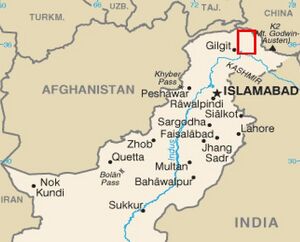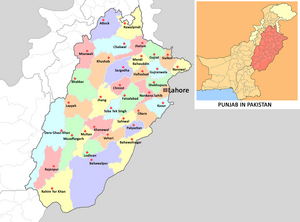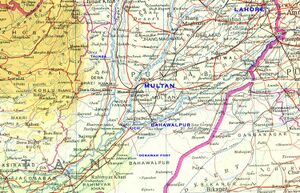Jhang



Jhang (Punjabi/Urdu: جھنگ,Hindi:झंग) is the principle city of Jhang District in the Punjab province of Pakistan. It is situated on the Chenab river at latitude 31.15° N and longitude 72.22°E[1]. According to the 1998 census of Pakistan it had a population of 387,418[2]
Jat clans in Jhang District
According to 1911 census, the following were the principal Muslim Jat clans in Jhang District :
Awan (2,392), Aura (814), Chadhar (3,414), Dhudhi (600), Gilotar (1,497), Ganda (637), Gill (558), Gondal (900), Gujar (1,265), Haral (4,988), Hidan (914), Hanjra (1,176), Heer (584), Johiya (1,721), Juta (544), Kalsan (533), Kaloka (638), Kanwan (678), Kharal (1,792), Khichi (581), Khokhar (8,666), Kudhan (1,045), Lak (1,319), Lali (1,640), Lana (1,001), Mahra (597), Mahun (1,471), Marral (826), Maru (956), Nauls (2,136), Nonari (983), Noons (1,083), Rajoka (1,262), Sahmal (994), Satar (801), Sial (595) and, Sipra (3,092)
Main Tribes
Aheer, Arain, Awan, Baloch, Bhangu, Bhatti, Bhatti, Bughlaira Khokhar, Chadhar, Chela, Dab, Dhudhi, Dogar, Fatyana, Ghenjera, Gilotar, Gujjar, Haral, Harya, Jabboana, Jatts, Jhandir, Johiya, Kathia, Khokhar, Kohja Jat, Lak, Lali, Mahra, Marral, Mohal, Nalere, Naswana, Naul, Nekokara, Nissowana, Pathan, Purnaya, Qazi, Qureshi, Qureshi, Qutab Shahi Khokhar, Rajput, Randhawa, Sangra, Sheikh, Sipra, Sipra, Syed, Tajraa, Vance,
History
The area was inhabited at the time of Alexander but the present city of Jhang is said to have been founded in the fifteenth century, and to have been destroyed by the river and re-founded during the reign of Aurangzeb. Under Mughal rule, the city flourished and was notable for commerce and trade. It was taken by Ranjit Singh in 1805[3].
During British Rule the towns of Jhang and Maghiana, lying two miles apart, became a joint municipality, then known as Jhang-Maghiana.
Jhang-Maghiana became a municipality in 1867. The income during the ten years ending 1902-3 averaged Rs.46,800 and the expenditure Rs. 44,200, in 1903-4 the income was Rs. 49,700 mainly derived from octroi. Maghiana lies on the edge of the highlands, overlooking the alluvial valley of the Chenab, while the older town of Jhang occupies the lowlands at its foot.
The Government offices and establishments had been removed to the higher site, and commerce declined in Jhang, which was no longer considered a place of importance. Maghiana, however, had a considerable trade in grain and country cloth, and manufactured leather, soap, locks and other brass-work. Maghiana also contained a civil hospital, whilst Jhang had a high school and a dispensary.
The population in 1901, according to the 1901 census of India, was 24,381 of whom 12,189 were Hindus and 11,684 were Muslims.
Jhang is the burial place of Heer and Ranjha, of Punjabi folklore.
Distribution in Punjab
Villages in Hoshiarpur district
- Jhang is village in Mukerian tahsil in Hoshiarpur district in Punjab.
Jang village in Firozpur district
Jang is village in Firozpur district in Punjab, India.
Jat History
- Malhi Jats - A large number of Malha or Malhi Jats is in Malwa today. Muslim and Sikh Malhi Jats found in large numbers in Jhang, Multan and Sialkot. In Sialkot they have 25 villages in a compact area.
- Sibipura: Today, this town is called "Shorkot" and is located in the Jhang district of Punjab, Pakistan. As per Diodorus [4], Arrian [5] and Strabo [8], the area surrounding Sibipura was occupied by a people called Sibi, during the time of Alexander's invasion of Punjab. Professor Eggermont [6] said, "J. Ph. Vogel showed that the mound of Shorkot (Jhang district, between Chenab, Indus, and Ravi rivers) represents the site of Sibipura, the town (pura) of the Sibis, which is mentioned in a Shorkot inscription". Even today Sibi or Sibia is a well known Jat clan in Punjab. Furthermore, Professor Eggermont [7] said, "However, I cannot possibly pass over in silence that in the very Vessantara Jataka the town over which Sanjaya, king of Sibi, ruled is called Jettuttara and not Aritta-pura". It is probably more likely the word "Jetuttara" is "Jetupura" or "Jatupura" which means the place where Jats live. The word "pura" in Sanskrit means "place". [8]
- Jhuria - They have originated from place called Jhang (झंग) in Multan (Sindh). [9]
- Rae Ahmed Nawaz Khan Kharal - Rai Ahmed Khan Kharal was one of the greatest freedom fighters in the Indian rebellion of 1857. He was a resident of Sandal Bar's famous town Jhamra in Jhang District, currently in Faisalabad, Punjab (Pakistan).
- Sibis - Srimad Bhagavatam also states that the Usinaras, the Sibi, the Madras, and the Kekayas were the direct descendants of Yayati's son Anu. Sibi or Sivi is stated to be son of Usinara [10]. [1]Consequently, in the literature, the Usinaras are often associated with the Shivis or Sibis (Sibois of the Greek writings) whose chief town Sibipura has been identified with Shorkot, in Jhang district in Pakistan.
- Gills - The people of Sipra Sub-Clan of Gill clan had mostly migrated towards Jhang. Most of them converted to Islam. Gills in Kabul are Moslems.In Sandal Baar, Kakkar Gill was the only prominent village of Gills. The Gills settled in Jhang, Montegomery and Shahpur in the West Punjab had converted to Islam.
- Dhillons - The Dhillon Sikh Dynasty and their clan founded the Bhangi Army (Misl), who ruled and governed in the 18th century over most of the major cities of Punjab, including Amritsar, Lahore, Multan, Chiniot, Jhang, Bhera, Rawalpindi, Hasan Abdal, Sialkot, Gujarat and large areas of central and western Panjab[11].
- Dorwals - Dorwal is gotra also found in Sikhs and Muslims. Dorwals of Rajasthan had come from Jhang area (Gujrawala) of Pakistan.
Notable persons
External links
References
- ↑ Falling Rain - Location of Jhang
- ↑ 1998 census of Pakistan
- ↑ Jhang-Maghiana article in the "Imperial Gazetteer of India", v. 14, p. 134.
- ↑ Diodorus (first century B.C.), Diodorus of Sicilly, translated by C.B. Welles, Vol. 8, Harvard University Press, Cambridge, Massachusetts, 1946, pp. 397, 401, 405.
- ↑ Arrian (95-175 A.D.), Anabasis of Alexander, translated by E.I. Robson, Harvard University Press, Cambridge, Massachusetts, 1966, pp. 37, 59, 69-72, 131-139 (Vol. II).
- ↑ Eggermont, P.H.L., Alexander's Campaign in Gandhara and Ptolemy's List of Indo-Scythian Towns, Orientalia Lovaniensia Periodica I, 1970, pp. 89, 86.
- ↑ Eggermont, P.H.L., Alexander's Campaign in Gandhara and Ptolemy's List of Indo-Scythian Towns, Orientalia Lovaniensia Periodica I, 1970, pp. 89, 86.
- ↑ History and study of the Jats. By Professor B.S Dhillon. ISBN-10: 1895603021 or ISBN-13: 978-1895603026.End of page 105
- ↑ Dr Mahendra Singh Arya, Dharmpal Singh Dudee, Kishan Singh Faujdar & Vijendra Singh Narwar: Ādhunik Jat Itihas (The modern history of Jats), Agra 1998 p.248
- ↑ “Anu, the fourth son of Yayati, had three sons, named Sabhanara, Caksu and Paresnu. From Sabhanara came a son named Kalanara, and from Kalanara came a son named Srnjaya. From Srnjaya came a son named Janamejaya. From Janamejaya came Mahasala; from Mahasala, Mahamana; and from Mahamana two sons, named Usinara and Titiksu.The four sons of Usinara were Sibi, Vara, Krmi and Daksa, and from Sibi again came four sons, named Vrsadarbha, Sudhira, Madra and atma-tattva-vit Kekaya....” (Srimad Bhagavatam, 9.23.1-4).
- ↑ History of the Jatt Clans - H.S Duleh (Translation from original Punjabi work "Jattan da Itihas" by Gurjant Singh).
Back to Jat Places in Pakistan

